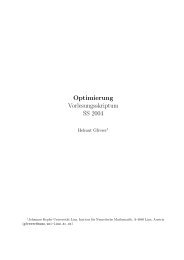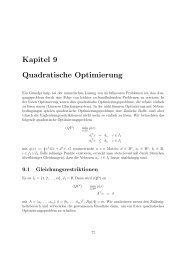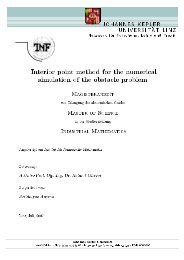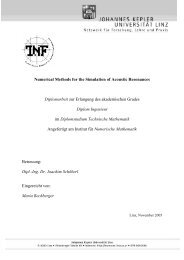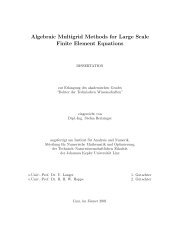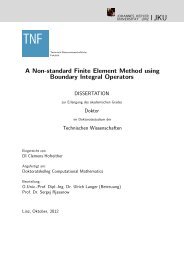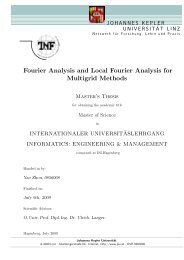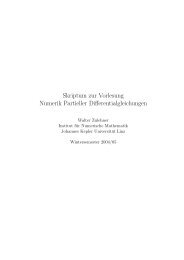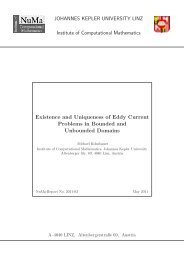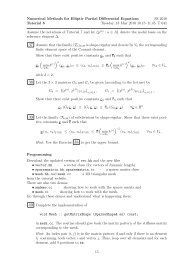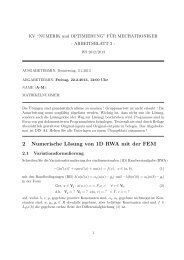Coupled FETI/BETI solvers for nonlinear potential problems in (un ...
Coupled FETI/BETI solvers for nonlinear potential problems in (un ...
Coupled FETI/BETI solvers for nonlinear potential problems in (un ...
Create successful ePaper yourself
Turn your PDF publications into a flip-book with our unique Google optimized e-Paper software.
4 Ulrich Langer and Clemens Pechste<strong>in</strong><br />
dimensions the s<strong>in</strong>gle layer <strong>potential</strong> operator V i is always elliptic, whereas <strong>in</strong> two<br />
dimensions, due to the logarithm <strong>in</strong> the f<strong>un</strong>damental solution, it is only elliptic if<br />
diam Ω i < 1. This property can always be achieved by a suitable coord<strong>in</strong>ate scal<strong>in</strong>g.<br />
After discretiz<strong>in</strong>g and elim<strong>in</strong>at<strong>in</strong>g t i, one obta<strong>in</strong>s the symmetric and stable approximation<br />
Si, BEM<br />
h := D i, h + ` α i<br />
2<br />
Mi, ⊤ h + Ki, ⊤ −1` h<br />
´V<br />
αi<br />
i, h 2<br />
M i, h + K i, h´<br />
, (8)<br />
where V i, h , K i, h , D i, h are the bo<strong>un</strong>dary element matrices correspond<strong>in</strong>g to V i, K i,<br />
D i, respectively, and M i, h is a mass matrix.<br />
Note that the two approximations Si, FEM<br />
h and Si, BEM<br />
h are compatible and both<br />
spectrally equivalent to the Galerk<strong>in</strong> matrices of the exact Steklov-Po<strong>in</strong>caré operators<br />
S i. The application of Si, FEM<br />
h or Si, BEM<br />
h simply corresponds to the solution of<br />
local Dirichlet <strong>problems</strong>. For details we refer to [11, 12].<br />
2.2 Tear<strong>in</strong>g and Interconnect<strong>in</strong>g<br />
Introduc<strong>in</strong>g separate variables u i on the local subdoma<strong>in</strong>s, one can re-en<strong>for</strong>ce the<br />
cont<strong>in</strong>uity of the solution u across <strong>in</strong>terfaces Γ ij by the constra<strong>in</strong>ts<br />
X p<br />
Bi ui = 0 , (9)<br />
i=1<br />
where the B i are <strong>in</strong>cidence matrices.<br />
Problem (2) can be written as a constra<strong>in</strong>t m<strong>in</strong>imization problem, as well as a<br />
saddle po<strong>in</strong>t problem <strong>in</strong>volv<strong>in</strong>g Lagrange multipliers. Us<strong>in</strong>g the notion of the pseudo<strong>in</strong>verse<br />
( † ) and a special projection P address<strong>in</strong>g the kernels of the sub<strong>problems</strong>, it<br />
is possible to elim<strong>in</strong>ate the primal <strong>un</strong>knowns u i. F<strong>in</strong>ally, one obta<strong>in</strong>s the discrete<br />
dual <strong>FETI</strong>/<strong>BETI</strong> <strong>for</strong>mulation, to f<strong>in</strong>d the Lagrange multiplier λ such that<br />
where the <strong>FETI</strong>/<strong>BETI</strong> operator F is def<strong>in</strong>ed by<br />
F = B<br />
where B = ˆB i˜p<br />
, i=1 SFEM/BEM h<br />
:=<br />
P T F λ = d, (10)<br />
FEM/BEM˜† ˆSh<br />
B ⊤ = X p<br />
˜†<br />
Bi<br />
ˆSFEM/BEM<br />
i=1<br />
i,h<br />
Bi ⊤ , (11)<br />
FEM/BEM˜p<br />
ˆSi, h<br />
. The application of the pseudo-<br />
i=1<br />
<strong>in</strong>verses [S FEM/BEM<br />
i, h<br />
] † can be realized by the simple solution of regularized local Neumann<br />
<strong>problems</strong>. S<strong>in</strong>ce F is symmetric positive def<strong>in</strong>ite on range(P), one can solve<br />
the dual problem (10) by a preconditioned conjugate gradient subspace iteration.<br />
The preconditioner<br />
M −1<br />
S,α = (BD −1<br />
α B ⊤ ) −1 BD α S FEM/BEM<br />
h<br />
D αB ⊤ (BD −1<br />
α B ⊤ ) −1 , (12)<br />
first <strong>in</strong>troduced and fully analyzed by Klawonn and Widl<strong>un</strong>d [7], satisfies the quasioptimal<br />
condition number estimate<br />
κ(PM −1<br />
S,αP T P T FP) ≤ C(1 + log(H/h)) 2 , (13)<br />
<strong>in</strong>dependent of the values–and there<strong>for</strong>e possible jumps–of the coefficients α i. It is<br />
well known that an appropriate norm of the<br />
√iteration error of the conjugate gradient<br />
method will decrease at least by a factor 2` κ−1<br />
´n<br />
√ κ+1<br />
<strong>in</strong> n steps. The robustness with



